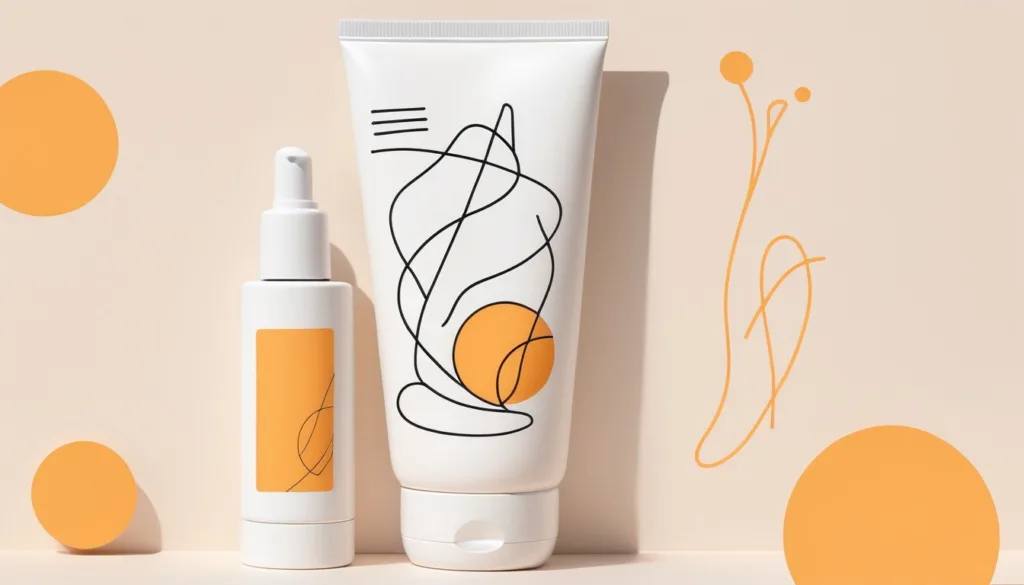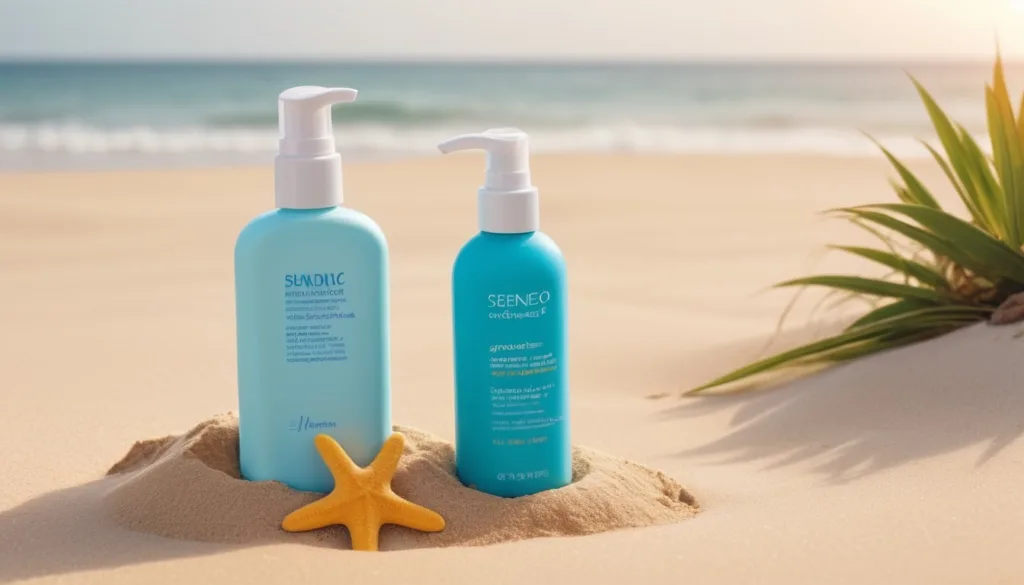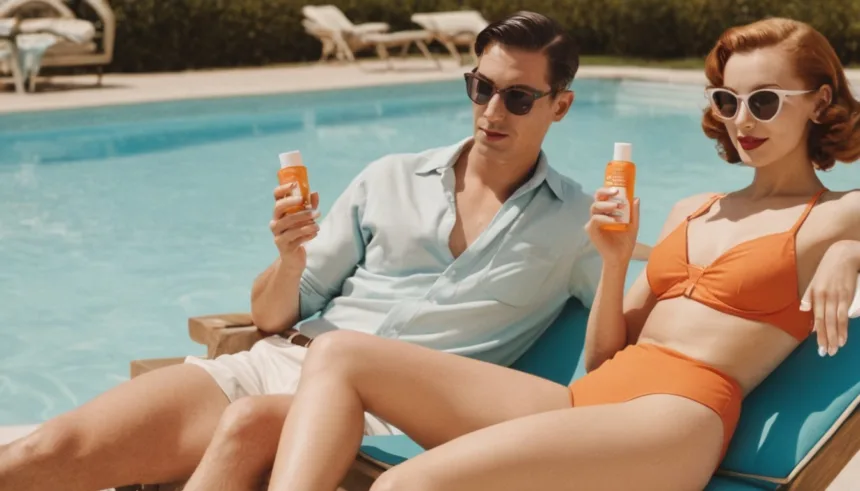It’s a bright, sunny day, and you’re gearing up for a day at the beach, and you reach for your sunscreen with moisturizer. You slather it on, feeling confident that your skin is protected from the sun’s fiery wrath. But wait, does adding a moisturizer to sunscreen actually make it less effective?
Now, you might be wondering, “Is sunscreen with moisturizer good?” Well, stick around because we’re about to dive deep into that question and uncover all the juicy details. So grab your sunscreen and get ready to soak up some knowledge about why this stuff is so darn important. Let’s do this!
Table of Contents
Why Combine Sunscreen with Moisturizer?

Let me tell you, we’re all about efficiency in our busy lives, right? So when we see a product promising to do double duty, it’s like music to our ears. That’s where sunscreen with moisturizer comes into play. It’s the ultimate two-in-one deal, saving you precious time and space in your skincare routine.
But here’s the burning question: Is sunscreen with moisturizer really as good as it sounds, or is it just another clever marketing trick? Well, gather ’round because we’re about to get to the bottom of this.
Two Birds, One Stone: The Convenience Factor
You see, sunscreen is like the shield protecting your skin from the fiery wrath of the sun’s UV rays. And moisturizer? Well, it’s like the knight in shining armour, keeping your skin hydrated and supple. Combine the two, and you’ve got yourself a skincare powerhouse.
But hold your horses! Before we start singing praises to this magical concoction, let’s take a closer look. Is sunscreen with moisturizer good and truly effective, or are we just falling for a clever marketing tactic? Let’s break it down! Here’s why I think combining sunscreen and moisturizer can be a game-changer:
- Convenience: Who doesn’t love a two-in-one deal? It saves me precious time in the morning rush and keeps my skincare routine simple.
- Cost-effectiveness: Buying one product instead of two? Count me in! It’s definitely friendlier on my wallet.
- Sun protection (Duh!): Sunscreen is like my shield against the sun’s fiery rays, helping me avoid sunburn and keeping my skin healthy.
- Hydration: Moisturizer is my go-to for keeping my skin hydrated and glowing. It’s like a refreshing drink for my face!
But, I’ve got to be real with you. It’s important to check if both sunscreen and moisturizer are present in effective quantities. And if my skin has specific needs, like extra hydration or sensitivity, I might still opt for standalone products. So, while I love the convenience of a combo, I always make sure it’s delivering the goods before I commit!
Quenching Thirsty Skin: Hydration Infused SPF

Now, we all know that moisturizer isn’t just about making our skin feel silky smooth, right? But here’s the twist: what if I told you that your sunscreen infused with SPF could also be a hydration powerhouse? That’s right, the added moisturizing properties in sunscreen can work wonders for keeping your skin happy and healthy under the blazing sun.
- Enhanced Hydration: Sunscreen with moisturizer provides deep hydration to your skin, helping to combat dryness and flakiness, especially in harsh weather conditions.
- Improved Skin Texture: The moisturizing properties in sunscreen can smooth out rough patches and uneven skin texture, leaving your skin feeling soft and supple.
- Long-lasting Comfort: By keeping your skin hydrated, moisturizer-infused sunscreen ensures long-lasting comfort throughout the day, preventing tightness and discomfort.
- Protection Against Environmental Stressors: Moisturizer helps strengthen your skin’s natural barrier, providing an additional layer of defence against environmental stressors like pollution and harsh weather.
- Prevention of Premature Aging: Hydrated skin is less prone to premature aging, so using sunscreen with moisturizer regularly can help minimize the appearance of fine lines, wrinkles, and age spots over time.
Quick Tip: Look for sunscreens with added moisturizers like hyaluronic acid or glycerine for an extra boost of hydration.
Finding the Right Balance
Now, we’ve explored how sunscreen with moisturizer acts as a hydration powerhouse. But finding the sweet spot between sun protection and hydration is key. And if you have dry, sensitive skin like me, chances are your mind may keep popping the question “Is sunscreen with moisturizer good?”
So if you find yourself standing in the skincare aisle, surrounded by rows of sunscreen with moisturizer options – like being a kid in a candy store, how do you know which one is the right fit for you? Here’s how:
- Know your skin type: Are you oily, dry, or somewhere in between? Understanding your skin’s needs is the first step in finding the right product.
- Check the labels: Look for sunscreens with moisturizers that contain hydrating ingredients like hyaluronic acid, glycerine, or ceramides.
- Lifestyle Check: Are you spending long hours outdoors, or do you mostly stay indoors? Your daily activities can impact the level of sun protection and hydration your skin needs.
- SPF Oh My! Make sure your sunscreen with moisturizer has broad-spectrum protection and at least SPF 30 to shield your skin from both UVA and UVB rays.
Wondering if your sunscreen might be causing dry skin? Check out my article to learn more about how sunscreen can affect your skin’s hydration levels!
Quick Tip: Consider your skin type: If you have oily skin, opt for a lightweight, oil-free formula. If you have dry skin, look for a sunscreen with moisturizer that’s rich and hydrating.
Sunscreen isn’t just about shielding your skin from harmful UV rays; it’s also about giving your skin the hydration it needs to thrive. But the question still arises: Is sunscreen with moisturizer good? Let’s keep digging.
Sunscreen’s Protective Power mixed with Hydration

Sunscreen is like a force field for your skin, protecting it from the sun’s harmful UV rays. But does combining it with moisturizer compromise its effectiveness, or does it enhance its protective power? Let’s explore further Is sunscreen with moisturizer good or not.
Armour Up: Shielding Against UV Damage
Now, here’s where things get interesting: what happens when you mix sunscreen with moisturizer? Does it make your skin even more invincible, or does it weaken the armour? That’s the burning question we’re here to answer!
Well, fear not, mixing sunscreen with moisturizer doesn’t necessarily compromise its protective power. In fact, some moisturizing ingredients can actually enhance the effectiveness of sunscreen, making it even better at shielding your skin from UV damage.
Here’s the lowdown on sunscreen’s protective power:
- Forms a barrier on your skin to block out harmful UV rays.
- Helps prevent sunburn, premature aging, and skin cancer.
- Works best when applied generously and reapplied every two hours, especially after swimming or sweating.
Quick Tip: opt for a broad-spectrum sunscreen with at least SPF 30 for optimal protection against both UVA and UVB rays.
So, the verdict? Mixing sunscreen with moisturizer can actually be a winning combination for keeping your skin safe and sound under the sun’s rays. Now, let’s delve deeper into how to find the right way to blend sun protection and hydration.
Mixing Matters: The Dos and Don’ts

Mixing sunscreen with moisturizer might seem like a genius time-saving hack, but trust me, not all formulas play nice together. So let’s explore the dos and don’ts of mixing skincare superheroes!
Chemistry Class 101: Understanding Product Compatibility
Alright, class is in session! Mixing sunscreen with moisturizer is like a science experiment for your skin. We’ll break down the chemistry behind skincare ingredients and discover which combinations are a match made in heaven and which ones are a recipe for disaster. But let’s revise the basics again.
Sunscreen: Shield Against the Sun’s Sneaky Rays!
First up, let’s talk about sunscreen. Picture zinc oxide, titanium dioxide, avobenzone, octocrylene, or oxybenzone—they’re the rock stars of sun protection. These ingredients work their magic by either soaking up or bouncing off UV radiation, keeping your skin safe from sun damage.
Moisturizer: Quench Your Skin’s Thirst with These Moisture Marvels!
Now, onto moisturizers! These babies come packed with all sorts of goodies. We’re talking humectants like glycerine or hyaluronic acid that pull moisture into your skin, emollients like oils or silicones that make your skin feel soft and smooth, and occlusives like petrolatum or dimethicone that seal in all that moisture.
Now, let’s break down compatibility:
- Humectants and Emollients: Picture humectants as thirsty sponges, soaking up moisture from the air or deeper layers of your skin, while emollients swoop in to keep things silky smooth on the surface. They’re like the dream team, working together to keep your skin hydrated and supple.
- Occlusives and Sunscreen: Occlusives are like the protective shields of your skincare routine, locking in moisture. But if you slap them on before sunscreen, they might mess with their ability to stick to your skin properly. Rule of thumb? Save the sunscreen for last to ensure it forms a solid barrier against those UV rays.
- Active Ingredients: Sometimes, certain active ingredients in skincare products don’t play nice with each other. For instance, some chemical sunscreen filters might lose their mojo when mixed with specific ingredients in moisturizers. So, always give those labels a peek and maybe chat with a skincare guru if you’re unsure about mixing and matching.
So, there you have it! By understanding the chemistry of skincare ingredients, we can whip up skincare routines that are not only effective but also super skin-friendly.
Read the Labels: Ingredient Compatibility Checklist
Not all ingredients play well together, and mixing incompatible products can spell trouble for your skin. From pilling to reduced effectiveness, we’ll decode those ingredient lists and steer clear of any skincare chemistry experiments gone wrong.
- Retinoids (such as Retinol, Retin-A, and Tretinoin): These ingredients can increase sensitivity to sunlight and may reduce the effectiveness of sunscreen.
- Alpha Hydroxy Acids (AHAs) and Beta Hydroxy Acids (BHAs): These exfoliating acids can increase skin sensitivity to sunlight and may irritate when used with certain sunscreen formulations.
- Vitamin C (L-ascorbic acid): While vitamin C itself is beneficial for the skin, it can sometimes destabilize certain sunscreen formulations, reducing their effectiveness.
- Niacinamide: This ingredient is generally safe to use with sunscreen, but in rare cases, it may cause flushing or irritation when combined with certain UV filters.
- Benzoyl Peroxide: This acne-fighting ingredient can increase skin sensitivity to sunlight and may cause irritation when used with certain sunscreen formulations.
- Essential Oils: Some essential oils, such as citrus oils, can increase skin sensitivity to sunlight and may cause phototoxic reactions when exposed to UV radiation.
- Chemical Fragrances: Synthetic fragrances in skincare products can sometimes cause irritation or allergic reactions when combined with sunscreen ingredients and exposed to sunlight.
- Exfoliating Scrubs: Physical exfoliants like scrub particles or brushes can create micro-tears in the skin, making it more susceptible to sun damage if not properly protected with sunscreen.
Always be cautious when combining skincare products, especially those containing active ingredients, with sunscreen. If you’re unsure about compatibility, it’s best to consult with a dermatologist or skincare professional.
Is Sunscreen With Moisturizer Good? Yes, If You Master The Layering!
Time to master the art of layering! Applying sunscreen and moisturizer in the correct order is key to ensuring they both work their magic. We’ll share expert tips on how to layer your skincare products for maximum sun protection and hydration without compromising either.
- Cleanser: Start with a gentle cleanser to remove any dirt, oil, and impurities from your skin. This sets the stage for better absorption of subsequent products.
- Toner (Optional): If you use a toner, apply it after cleansing to rebalance your skin’s pH levels and prepare it for the next steps. However, not everyone needs a toner, so this step is optional.
- Serum/Treatment: Next, apply your serums or treatment products. These often contain active ingredients like antioxidants, vitamins, or hyaluronic acid, targeting specific skin concerns such as aging, hydration, or brightening.
- Moisturizer: After serums, lock in hydration with a moisturizer suited for your skin type. Moisturizers help maintain your skin’s moisture barrier and prevent transepidermal water loss.
- Sunscreen: Finally, apply sunscreen as the last step in your skincare routine, especially in the morning. Go for a broad-spectrum sunscreen with SPF 30 or higher to shield your skin from both UVA and UVB rays. Make sure to apply an adequate amount and reapply every two hours if you’re exposed to the sun.
Want that radiant skin? Check out my guide on finding the perfect moisturizer for that lit-from-within glow.
Trying Before Applying
Before you go all-in with that sunscreen-moisturizer combo, let’s take a detour to patch test paradise! It’s essential to ensure your skin doesn’t throw a tantrum in response to the formula. Here’s a detailed guide on how to do it:
- Choose a Patch Test Area: Select a small, inconspicuous area on your skin, such as the inside of your wrist or behind your ear. Make sure the area is clean and dry before proceeding.
- Apply a Small Amount: Take a small amount of the sunscreen-moisturizer combo and apply it to the patch test area. Use just enough to cover a dime-sized area.
- Observe for Reactions: Leave the product in the patch test area for at least 24 hours. During this time, observe for any signs of irritation, redness, itching, or burning sensations. If you experience any discomfort, remove the product immediately and rinse the area with water.
- Monitor for 48 Hours: While most reactions occur within the first 24 hours, it’s advisable to monitor the patch test area for a total of 48 hours to ensure there are no delayed reactions.
- Evaluate Results: After 48 hours, assess the patch test area. If there are no adverse reactions and your skin feels comfortable, it’s likely safe to use the sunscreen-moisturizer combo on your face.
DIY Danger Zone: The Risks of Homemade Concoctions
Now, I know it’s tempting to play mad scientist and whip up your own sunscreen-moisturizer blend, but proceed with caution! DIY skincare can be a slippery slope, leading to potential disasters like skin irritation or ineffective protection. Let’s stick to the experts’ formulations for optimal skin health, shall we?
Mixing vs. Layering

And now, for the moment of truth! Is sunscreen with moisturizer good? Mixing sunscreen with moisturizer can be a convenient option, but it’s not without its risks. We’ll weigh the pros and cons of mixing versus layering to help you decide which approach is best suited to your skincare routine and lifestyle. Let’s find the perfect balance for your skin, shall we?
Mixing
Pros:
- Convenience: Mixing sunscreen with moisturizer saves time and simplifies your skincare routine, especially if you’re always on the go.
- Even Distribution: When mixed, sunscreen and moisturizer are evenly distributed, ensuring uniform coverage on the skin.
Cons:
- Dilution of SPF: Combining sunscreen with moisturizer may dilute the SPF, reducing its effectiveness in protecting your skin from harmful UV rays.
- Interference with Formulas: Some ingredients in moisturizers might interact with the sunscreen’s active ingredients, compromising its efficacy.
Layering
Pros:
- Customization: Layering allows you to use separate products tailored to your specific skincare needs. You can choose a moisturizer and sunscreen with formulations best suited for your skin type and concerns.
- Optimal Sun Protection: Applying sunscreen as a separate layer ensures that you’re getting the full SPF protection specified on the sunscreen’s label, without any dilution.
Cons:
- Time-Consuming: Layering requires applying multiple products sequentially, which may take more time compared to mixing.
- Potential Product Pilling: Layering too many products can sometimes lead to product pilling, where the layers don’t absorb well into the skin and form clumps or flakes.
Final Verdict
Ultimately, whether you choose to mix or layer sunscreen and moisturizer depends on your preferences, lifestyle, and skincare goals. If convenience is paramount and you’re short on time, mixing may be a suitable option. However, if you prioritize optimal sun protection and customization, layering is the way to go.
Finding the perfect balance for your skin involves considering these factors and experimenting with different approaches to see what works best for you. Remember, the most important thing is to consistently use sunscreen and moisturizer to keep your skin healthy and protected.
Conclusion
To Moisturize or Not to Moisturize? That is the Sunscreen Question.
So, is sunscreen with moisturizer good to an extent that it’s the ultimate skincare dream team? While it certainly offers convenience and hydration, it ultimately boils down to personal preference and skin needs. Remember, whether you opt for separate products or a combo, the most important thing is to keep slathering on that sunscreen and keeping your skin healthy and happy!
With sunscreen (and maybe a little help from moisturizer), you can bask in the sunshine without a worry in the world. So go ahead, enjoy those sunny days, and keep shining bright like the star you are!



Leave a Reply